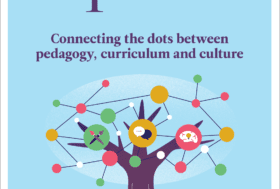Maximising engagement in the Early Years
Sayeh Mariner and Matt Shurlock, Essa Primary Academy, Bolton, UK
In this video, Sayeh Mariner and Matt Shurlock discuss maximising engagement in early childhood education at their setting in Bolton where 80 percent of learners have English as an additional language. They talk about:
- actions taken to maximise engagement and address barriers to learning
- building an effective learning environment that is calming and enjoyable
- initiatives to promote parental engagement.
You can read Sayeh and Matt’s article on this topic in Impact.
You need to be logged in to view this video
Our community is based in one of the most deprived areas in Bolton. We’ve got high levels of English as an additional language, over 80 per cent. And those barriers to learning, those higher levels of deprivation, we’re very aware that they have a significant impact in terms of children’s attainment and their learning. And that was really a starting point for us for the project. We wanted to maximise engagement and make improvements in language, writing and maths.
So the Leuven scales have always been something that we used at the beginning of the year in terms of assessing the children’s wellbeing and involvement skills when they come into reception as part of transition. But then I attended some CPD that enabled us to look at that a little bit more closely in terms of utilising that alongside our focused child approach.
And we knew through our research, particularly for our Impact article, that it was really important to have high levels of wellbeing and involvement in terms of children being able to attain. If they haven’t got those high levels, then it’s very unlikely that they’re going to be retaining any of that information, any of those key skills and concepts that you want to teach them.
If their levels are low, then they’re unlikely to be able to remember any of that. So we knew that had to be at the heart of everything that we did in order to be able to get that high engagement so that we can make a difference to our attainment and our progress data.
We broke it down into three main approaches in terms of maximising engagement for our project. The first approach was based on stimulating learning opportunities, and providing those through a learning environment that was full of interest and curiosity, and really inspired the children.
In terms of our learning environment, I’m a very strong believer that if we set up really exciting provocations that the children want to have a go at, and us as adults want to explore them, we’re much more likely to get those high levels of engagement with the children. And they’ll be learning without even realising that they’re doing it because they’re having so much fun and enjoying learning through play.
It was really important to us when creating our environment that we had a calming ethos and created that nurturing space for children to feel comfortable in. So we have low level lighting. We never have the big lights on. Low level lighting lots of fairy lights and lamps.
And it’s very much set up as a home from home with natural open-ended resources that stimulate the children. And particularly for us, it was important, because a lot of them are from disadvantaged backgrounds and quite poor home lives, that we wanted them to have that safe, nurturing environment where they could build up those relationships, and demonstrate those high levels of wellbeing, involvement.
And then that, in turn, then impacts in terms of their characteristics of effective learning and their engagement with the provision. We need to support children’s wellbeing in terms of their transitions to reception. In particular following the pandemic, we’ve noticed that children’s resilience levels are low.
And we look at their wellbeing and involvement levels using the Leuven scales. And again, that’s been impacted as a result of the pandemic and the fact that they’ve spent so much time at home, they might have had quite a disrupted preschool year or not been to preschool at all.
So we’re really building those children up in terms of them as a learner and them attending school. So we want them to feel really comfortable and nurtured, and develop those strong relationships. One way that we do that is by doing a wellbeing check when the children come into school every day.
We use a book called The Colour Monster. The children very early on in September are taught the story, and we talk about colours representing feelings. And then the children use a little stone that has their name on. And then they will allocate it to a colour when they come in first thing in the morning.
So it works well as a self-registration for us in terms of developing those routines with the children, but also then we can clearly see if a child’s put their name in the sad pot or in the confused pot, or in the scared pot, then that prompts us to be able to go and have a conversation with that child, and see if we can support them in something in terms of their wellbeing, and then settling into school.
So that’s one way that we do that when they come in the morning. But obviously, we will… we develop those close relationships with the children as key workers and as part of that relationship and that system in terms of being able to observe and assess those children all the time. So we will very quickly be able to support a child if they’re looking like they need some support with anything in terms of their wellbeing.
Another aspect in terms of providing stimulating learning opportunities is in terms of the setup of activities that we provide. So we do that by looking at the children’s interests and using that as a focus in terms of the provocations that we might provide.
And we use feeding forward sheets so that we really recognise that child’s interested in dinosaurs, for example. This child’s got another interest somewhere else. And how we can use those to implement different types of provision and focus on specific skills that they might need to work on. We will look at ongoing and accurate assessments based on the children’s needs in terms of providing opportunities for children to learn.
So the second approach that we looked at in terms of the project was based on quality interactions. And that came from some inspirational CPD that I attended with Anna Ephgrave, looking at her approach to teaching in the moment, and quality interactions that adults can have with children in terms of moving them on in their next steps in the moment of teaching.
I was lucky enough to attend one of Anna Ephgrave’s courses, which were focused on planning in the moment. It was really good to hear her focus child approach, but also the fact that teaching in the moment is at the heart of her pedagogy for her early years and her outstanding settings that she teaches in, and that she leads. And I knew then when I heard her speak, that that was the direction that we wanted to go in. I think we had elements of things already that we were doing.
But the fact that we could put it down in terms of have that focus child approach, that deep dive into children’s learning, those quality interactions and those quality conversations then with parents directly following children being a focus child, that would make a difference. And that would help us to improve on our data, but improve on the quality of learning that takes place in our setting.
We looked at 10 pedagogical interactions, and introducing those from Anna Ephgrave’s pedagogy. And the staff were trained to use those 10 interactions in terms of teaching in the moment with children. To do this, we looked at Ofsted’s criteria for effective teaching in the early years, and we honed in on those interactions.
Staff had those interactions printed and put onto their lanyards as reminders for them when they were interacting with children in provision, and then they were using those and well-trained to use those in terms of facilitating conversations that they were having with children to move them on.
So an example of that might be that a child was trying to blend a word containing the oi diagraph, but the teacher had noticed that they were struggling with the oi phoneme. So they sensitively intervened there and model, which is one of the interactions, model how to use the oi diagraph using a sound matMulti-academy trust – a group of schools working in collabor… More.
They might relate it to a catchphrase so that they’re hooking them into that to remind them of that knowledge in terms of the phoneme. And then the outcome of that observation would be that then the child is able to successfully blend the word.
The teacher, the practitioner would then know that — “right, later on in the day, I might go and revisit that just to check that knowledge is embedded, or revisit it later in the week.” So we use that through all of our interactions with children to help to move them on in terms of their need and their level of development at that time.
So the third part of the project was labelled focus child. And this part of the project aimed to increase parental engagement in pupil’s learning. And we know from the existing literature that it’s unequivocally positive about the impact that higher parental engagement has on pupils’ learning, and there’s teachers across the key stage. We recognise that as well.
So we were trying to get parents more involved in their pupil’s learning, and this particular part of the project really focused on that. But we didn’t just want to increase the quantity of parent engagement. We also wanted to look at the quality.
So using Anna Ephgrave’s work, and particularly the focus child approach. Every child became a focus child once per term throughout the year. When they were a focus child, a learning journey was created. This is a document that charts a thorough investigation into where they’re at with their learning, and where they need to move to next.
So it’s really like a deep dive into an individual learning plan. It had a measure of wellbeing, as well as looking at where they were progressing through the early years curriculum. Once that document was completed by the adults in the setting, a face-to-face meeting was held with parents, and the learning journal was discussed looking at where the pupil was at and aspects of learning that had been taking place.
So the parent got a really good insight into how their pupil was progressing through school. Once the learning journal had been discussed, the next steps were agreed in partnership with the parents. So it was a collaborative effort between the adults from the early years setting and parents in terms of where is learning going to move.
Really building those bridges between home and school learning. And then this focused child approach then took the place of your traditional parents evening that might happen once a term, and with just a different way of engaging with parents.
So the school has a number of staff who are bilingual, and they are happy to help and support with focus child meetings, interpreting and allowing parents to access the really important information about their pupil’s learning.
If no staff speaks the language that the family does, often family members, siblings, aunts, uncles, aunts, or uncles or friends of the family will come down and act as interpreters. And as an absolute last resort, if there is no one who can act as interpreter, modern technology such as Google Translate is a way that you can open up access to parents understanding what’s going on with their pupil’s learning within the setting.
So we can look at the impact of this project in two main areas — the impact on pupils, and the impact on parents. Now it was a small-scale project with no control group. So we’re not making any claims to causation. However, the adults in the early years setting described many occasions where they were observing pupils really developing their understanding and interacting both with the quality conversations and the engaging learning opportunities.
And it was through these quality conversations between the adults and the pupils that we got an understanding of just the impact that the project was having on pupil’s understanding, pupil’s confidence, and the pupil’s engagement with what they were doing.
The impact that this project had on pupils’ achievements were seeing across reading, writing, maths, and good levels of development. In terms of the reception data, it was part of an upward trend that took place in the reception data after the project took place.
And looking at more details of the outcomes, it seemed to have a particular positive impact on the achievement of boys. Before the project took place, levels of GLD were at 44 per cent. Post project, this had increased to 67 per cent, which was beyond the national standard that particular year.
Obviously, we’ve had a global pandemic since. And some of the, kind of, future progress has been masked by that or limited by that. But we’d expect to see these positive progressions continue through with the data. So one of the future implications that came out of the project is asking ourselves the question — well, what happened if we took what has worked well in reception and move it up into Year 1?
So taking a lot of the approaches, and then moving it up into that first year of Key Stage 1. Unfortunately, the global pandemic has kind of limited some of the impact of that work. But in terms of the approach with the engaging learning opportunities, the quality interactions, those things are being embedded along with the changes to the environment, which have a really positive impact on learning that’s taking place in the Year 1 classrooms.
So the other aspect of the project is the impact that this had on parents. After the project took place, we saw an increase in parent engagement in terms of the numbers who are actually attending sessions. So pre-project attendance at the kind of traditional parents evening was about 60 per cent. Post-project, this had moved up to 86 per cent.
And this has continued to climb as a project has been rolled out year-on-year. And now getting in excess of 90 per cent attendance every term throughout the whole year, which is a real positive as one of the aims was specifically engaging parents. And that is absolutely happening there.
So this suggests that the focus child approach is a preferred method of engaging with your pupils’ learning as opposed to that traditional method. Parents fed back that they were really… they were really appreciative of being involved in the pupil’s learning, understanding how they could be involved in charting those next steps, and actually enjoyed the process as well.







I a m a English language tutor I recently passed TEFL level 3.